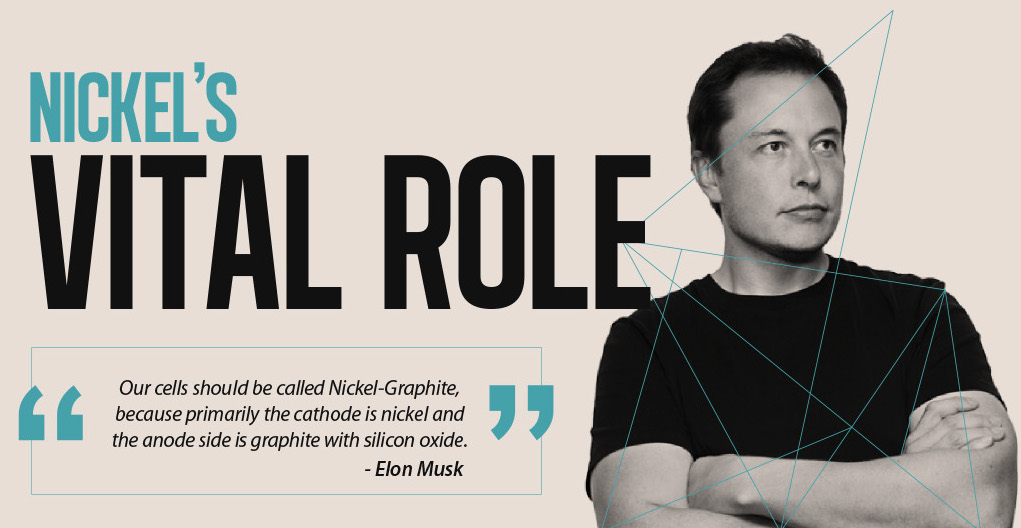Energy
Nickel: The Secret Driver of the Battery Revolution

Nickel: The Secret Driver of the Battery Revolution
Commodity markets are being turned upside down by the EV revolution.
But while lithium and cobalt deservedly get a lot of the press, there is another metal that will also be changed forever by increasing penetration rates of EVs in the automobile market: nickel.
Today’s infographic comes to us from North American Nickel and it dives into nickel’s rapidly increasing role in lithium-ion battery chemistries, as well as interesting developments on the supply end of the spectrum.
Nickel’s Vital Role
Nickel’s role in lithium-ion batteries may still be underappreciated for now, but certainly one person familiar with the situation has been vocal about the metal’s importance.
Our cells should be called Nickel-Graphite, because primarily the cathode is nickel and the anode side is graphite with silicon oxide.
– Elon Musk, Tesla CEO and co-founder
Indeed, nickel is the most important metal by mass in the lithium-ion battery cathodes used by EV manufacturers – it makes up about 80% of an NCA cathode, and about one-third of NMC or LMO-NMC cathodes. More importantly, as battery formulations evolve, it’s expected that we’ll use more nickel, not less.
According to UBS, in their recent report on tearing down a Chevy Bolt, here is how NMC cathodes are expected to evolve:
| Cathode | Year | Nickel | Manganese | Cobalt |
|---|---|---|---|---|
| NMC | Present | 33% | 33% | 33% |
| NMC | 2018 | 60% | 20% | 20% |
| NMC | 2020 | 80% | 10% | 10% |
The end result? In time, nickel will make up 80% of the mass in both NCA and NMC cathodes, used by companies like Tesla and Chevrolet.
Impact on the Nickel Market
Nickel, which is primarily used for the production of stainless steel, is already one of the world’s most important metal markets at over $20 billion in size. For this reason, how much the nickel market is affected by battery demand depends largely on EV penetration.
EVs currently constitute about 1% of auto demand – this translates to 70,000 tonnes of nickel demand, about 3% of the total market. However, as EV penetration goes up, nickel demand increases rapidly as well.
A shift of just 10% of the global car fleet to EVs would create demand for 400,000 tonnes of nickel, in a 2 million tonne market. Glencore sees nickel shortage as EV demand burgeons.
– Ivan Glasenberg, Glencore CEO
The Supply Kicker
Even though much more nickel will be needed for lithium-ion batteries, there is an interesting wrinkle in that equation: most nickel in the global supply chain is not actually suited for battery production.
Today’s nickel supply comes from two very different types of deposits:
- Nickel Laterites: Low grade, bulk-tonnage deposits that make up 62.4% of current production.
- Nickel Sulfides: Higher grade, but rarer deposits that make up 37.5% of current production.
Many laterite deposits are used to produce nickel pig iron and ferronickel, which are cheap inputs to make Chinese stainless steel. Meanwhile, nickel sulfide deposits are used to make nickel metal as well as nickel sulfate. The latter salt, nickel sulfate, is what’s used primarily for electroplating and lithium-ion cathode material, and less than 10% of nickel supply is in sulfate form.
Not surprisingly, major mining companies see this as an opportunity. In August 2017, mining giant BHP Billiton announced it would invest $43.2 million to build the world’s biggest nickel sulfate plant in Australia.
But even investments like this may not be enough to capture rising demand for nickel sulfate.
Although the capacity to produce nickel sulfate is expanding rapidly, we cannot yet identify enough nickel sulfate capacity to feed the projected battery forecasts.
– Wood Mackenzie

Who’s Building the Most Solar Energy?
This was originally posted on our Voronoi app. Download the app for free on iOS or Android and discover incredible data-driven charts from a variety of trusted sources.
In 2023, solar energy accounted for three-quarters of renewable capacity additions worldwide. Most of this growth occurred in Asia, the EU, and the U.S., continuing a trend observed over the past decade.
In this graphic, we illustrate the rise in installed solar photovoltaic (PV) capacity in China, the EU, and the U.S. between 2010 and 2022, measured in gigawatts (GW). Bruegel compiled the data..
Chinese Dominance
As of 2022, China’s total installed capacity stands at 393 GW, nearly double that of the EU’s 205 GW and surpassing the USA’s total of 113 GW by more than threefold in absolute terms.
| Installed solar capacity (GW) | China | EU27 | U.S. |
|---|---|---|---|
| 2022 | 393.0 | 205.5 | 113.0 |
| 2021 | 307.0 | 162.7 | 95.4 |
| 2020 | 254.0 | 136.9 | 76.4 |
| 2019 | 205.0 | 120.1 | 61.6 |
| 2018 | 175.3 | 104.0 | 52.0 |
| 2017 | 130.8 | 96.2 | 43.8 |
| 2016 | 77.8 | 91.5 | 35.4 |
| 2015 | 43.6 | 87.7 | 24.2 |
| 2014 | 28.4 | 83.6 | 18.1 |
| 2013 | 17.8 | 79.7 | 13.3 |
| 2012 | 6.7 | 71.1 | 8.6 |
| 2011 | 3.1 | 53.3 | 5.6 |
| 2010 | 1.0 | 30.6 | 3.4 |
Since 2017, China has shown a compound annual growth rate (CAGR) of approximately 25% in installed PV capacity, while the USA has seen a CAGR of 21%, and the EU of 16%.
Additionally, China dominates the production of solar power components, currently controlling around 80% of the world’s solar panel supply chain.
In 2022, China’s solar industry employed 2.76 million individuals, with manufacturing roles representing approximately 1.8 million and the remaining 918,000 jobs in construction, installation, and operations and maintenance.
The EU industry employed 648,000 individuals, while the U.S. reached 264,000 jobs.
According to the IEA, China accounts for almost 60% of new renewable capacity expected to become operational globally by 2028.
Despite the phasing out of national subsidies in 2020 and 2021, deployment of solar PV in China is accelerating. The country is expected to reach its national 2030 target for wind and solar PV installations in 2024, six years ahead of schedule.
-

 Energy4 days ago
Energy4 days agoWho’s Building the Most Solar Energy?
-

 Wealth2 weeks ago
Wealth2 weeks agoCharted: Which Country Has the Most Billionaires in 2024?
-

 Markets2 weeks ago
Markets2 weeks agoThe Top Private Equity Firms by Country
-

 Jobs1 week ago
Jobs1 week agoThe Best U.S. Companies to Work for According to LinkedIn
-

 Economy1 week ago
Economy1 week agoRanked: The Top 20 Countries in Debt to China
-

 Misc1 week ago
Misc1 week agoCharted: Trust in Government Institutions by G7 Countries
-

 Energy1 week ago
Energy1 week agoMapped: The Age of Energy Projects in Interconnection Queues, by State
-

 Mining1 week ago
Mining1 week agoVisualizing Global Gold Production in 2023













